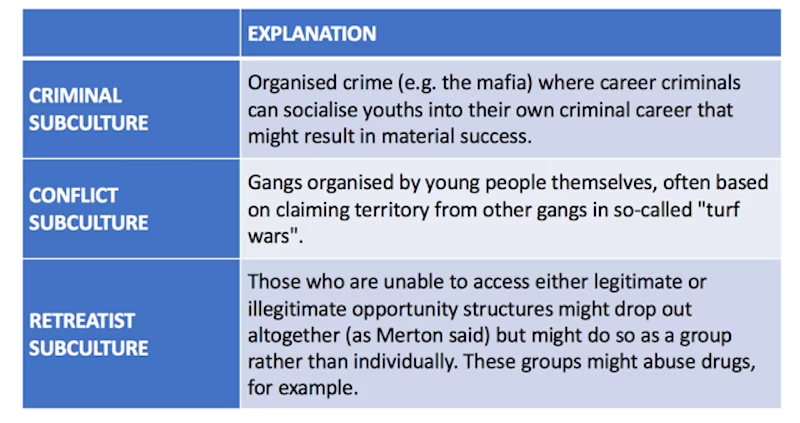Study Notes
Cloward and Ohlin: Illegitimate Opportunity Structures (1960)
- Level:
- AS, A-Level, IB
- Board:
- AQA, Edexcel, OCR, IB, Eduqas, WJEC
Last updated 31 Aug 2020
Cloward and Ohlin sought to combine the theories of Merton and Cohen to explain the different kinds of criminal subcultures they identified in contemporary America.
Echoing Merton, they argued that there was a "legitimate opportunity structure" (what Merton had meant by the socially-acceptable means to achieving social goals), but they also identified an alternative "illegitimate opportunity structure" which was available through gang membership.
However, just as not all people could easily access the legitimate opportunity structure and material success (Merton's concept of strain), there could also be a strain in relation to illegitimate opportunity structures. Because someone is unable to become wealthy through working hard and gaining qualifications does not mean that they will easily find a criminal path to wealth and success. Some people live in locations where an existing criminal subculture already exists while others do not. Furthermore, the types of subcultures available vary. This goes some way to explaining why not all those who find legitimate opportunity structures blocked turn to crime.
Cloward and Ohlin suggest three types of deviant subculture:

Evaluating Cloward and Ohlin
Although Cloward and Ohlin’s three forms of subculture appear distinct, most criminal gangs would have elements of two or more of these subcultures. Drug use, for example, often plays a part in criminal gangs, while the sorts of "turf wars" carried out by "conflict subcultures" is often linked to organised crime, for instance drug dealing, rather than only being about conflict for its own sake. Thus, it is not clear that they have identified three distinct subcultures.
As with other functionalist subcultural theories, Cloward and Ohlin write about working-class crime and predominantly about males, yet do not tackle broader issues relating to social class or gender. They do not question why, in the meritocratic society described by most functionalists, working-class youths are generally denied access to legitimate opportunity structures. Nor do they explain why girls, who are also denied access to these structures, do not react in the same ways that boys do.
You might also like
Domestic Abuse: Precursor to Mass Violence
2nd November 2017
Modern Slavery
22nd February 2018
Male Suicide
22nd May 2018
Social and Community Crime Prevention
Study Notes
'Elder Abuse'
23rd May 2019
Jeffrey Epstein: Filthy Rich
18th June 2020
Heidensohn - Feminist Theories of Crime and Deviance
Topic Videos
Why are women so angry after the killing of Sarah Everard?
23rd March 2021